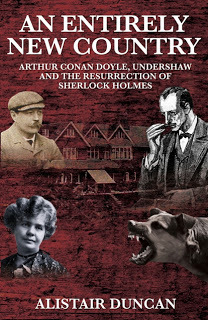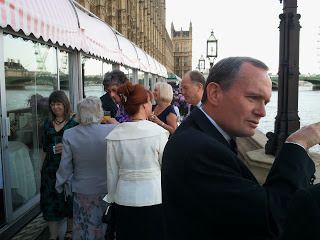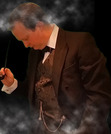Alistair Duncan's Blog, page 101
June 15, 2011
Read-through nearly complete
I have about eighty pages of my manuscript to read through and perhaps tweak before it goes for for its second round of editing.
Published on June 15, 2011 07:35
June 10, 2011
221B Layout
As most Sherlockians / Holmesians will know, one of the questions that has occupied scholars in the field the most has been the location of 221B Baker Street. However I would venture to suggest that the arguments over the internal configuration of the address are also a worthy topic of debate.
The layout of the address, and in particular the famous sitting room, has been subject to some debate. The lack of any totally agreed format has been in evidence from the considerably wide ranging layouts given to us in the various film and television adaptations.
The one consistent mistake is that the sitting room is portrayed as larger than it would have been in reality. For all its faults, the Sherlock Holmes Museum at 239 Baker Street is still representative of the houses of the period and its sitting room is modest in size.
Pictorial representations of the layout have also made their way into journals and other media. An example is the one below.
 By Ernest H. Short. Published in the Strand magazine in 1950.
By Ernest H. Short. Published in the Strand magazine in 1950.
This depiction appears, at first glance, to conform to Watson's original description of 221B as stated in STUD:
"They consisted of a couple of comfortable bed-rooms and a single large airy sitting-room, cheerfully furnished, and illuminated by two broad windows."
It is, however, wrong as I shall demonstrate.
On occasion the layout presented to the viewer was actually done so with a specific (although not necessarily laudable) aim in mind.
Ian Richardson, in an interview given to David Stuart Davies (for the latter's book Starring Sherlock Holmes), stated that one aspect of the layout of his 221B was made against his wishes. It was made very clear in his 221B that Holmes and Watson had separate bedrooms by having them both adjoin the sitting room (similar to the drawing above). Richardson suggested that this was designed specifically to please conservative elements and stress (as if it needed stressing) that there was no homosexual relationship between the two men.
The topic of Holmes's sexuality is an emotive one with strong opinions on both sides and it is a discussion somewhat outside the scope of this article. That said, I think it was wrong for the filmmakers in this instance to have pandered to (perceived or real) intolerance by taking this step. The stories are, after all, first and foremost about the solving of crime and the enacting of justice (even if it is sometimes Holmes's justice rather than that of the land). They are not about the lead characters' sexual preferences.
Returning to the matter in hand, what do we really know about the layout from Conan Doyle's original texts?
• The sitting room was on the first floor (SCAN & MAZA).
• There were 17 steps from the ground floor hall up to the first floor (SCAN).
• Holmes's bedroom adjoined the sitting room and communicated directly with it. A second door connected to the landing (SCAN & MAZA).
• Watson's bedroom was on the second floor and to the back of the building. Through the rear window a plane tree could be seen (SPEC & THOR).
• The sitting room had two large windows which faced onto the street (STUD & BERY).
This basic configuration is born out by the museum (as mentioned above).
Now Conan Doyle was famous for being inconsistent and it was in MAZA that Holmes's bedroom gained a second door that connected with the sitting room. This was a device to ensure that the plot worked but does not get away from the fact that it was architecturally absurd.
In BERY Watson says that the windows facing onto the street are bow windows. The established architecture of Baker Street houses makes clear that this was never the case. An earlier allusion to this type of window was made in SPEC when Miss Stoner was described by Watson as "sitting in the window".
There are of course many other clues about 221B's layout and they appear throughout the canon. What facts have you unearthed?
The layout of the address, and in particular the famous sitting room, has been subject to some debate. The lack of any totally agreed format has been in evidence from the considerably wide ranging layouts given to us in the various film and television adaptations.
The one consistent mistake is that the sitting room is portrayed as larger than it would have been in reality. For all its faults, the Sherlock Holmes Museum at 239 Baker Street is still representative of the houses of the period and its sitting room is modest in size.
Pictorial representations of the layout have also made their way into journals and other media. An example is the one below.
 By Ernest H. Short. Published in the Strand magazine in 1950.
By Ernest H. Short. Published in the Strand magazine in 1950. This depiction appears, at first glance, to conform to Watson's original description of 221B as stated in STUD:
"They consisted of a couple of comfortable bed-rooms and a single large airy sitting-room, cheerfully furnished, and illuminated by two broad windows."
It is, however, wrong as I shall demonstrate.
On occasion the layout presented to the viewer was actually done so with a specific (although not necessarily laudable) aim in mind.
Ian Richardson, in an interview given to David Stuart Davies (for the latter's book Starring Sherlock Holmes), stated that one aspect of the layout of his 221B was made against his wishes. It was made very clear in his 221B that Holmes and Watson had separate bedrooms by having them both adjoin the sitting room (similar to the drawing above). Richardson suggested that this was designed specifically to please conservative elements and stress (as if it needed stressing) that there was no homosexual relationship between the two men.
The topic of Holmes's sexuality is an emotive one with strong opinions on both sides and it is a discussion somewhat outside the scope of this article. That said, I think it was wrong for the filmmakers in this instance to have pandered to (perceived or real) intolerance by taking this step. The stories are, after all, first and foremost about the solving of crime and the enacting of justice (even if it is sometimes Holmes's justice rather than that of the land). They are not about the lead characters' sexual preferences.
Returning to the matter in hand, what do we really know about the layout from Conan Doyle's original texts?
• The sitting room was on the first floor (SCAN & MAZA).
• There were 17 steps from the ground floor hall up to the first floor (SCAN).
• Holmes's bedroom adjoined the sitting room and communicated directly with it. A second door connected to the landing (SCAN & MAZA).
• Watson's bedroom was on the second floor and to the back of the building. Through the rear window a plane tree could be seen (SPEC & THOR).
• The sitting room had two large windows which faced onto the street (STUD & BERY).
This basic configuration is born out by the museum (as mentioned above).
Now Conan Doyle was famous for being inconsistent and it was in MAZA that Holmes's bedroom gained a second door that connected with the sitting room. This was a device to ensure that the plot worked but does not get away from the fact that it was architecturally absurd.
In BERY Watson says that the windows facing onto the street are bow windows. The established architecture of Baker Street houses makes clear that this was never the case. An earlier allusion to this type of window was made in SPEC when Miss Stoner was described by Watson as "sitting in the window".
There are of course many other clues about 221B's layout and they appear throughout the canon. What facts have you unearthed?
Published on June 10, 2011 04:58
June 8, 2011
Getting there one page at a time
I am presently putting myself through that torture that most authors inflict upon themselves - the read-through. This is where you repeatedly scan through your WIP looking for the flaws that you are convinced you missed the last time you read it through. The ironic, and all too common, result is that you tinker with something that was fine and thus create a problem (which you often won't see until the next read-through).
I will eventually (under deadline pressure if past experience is any guide) break out of this cycle. When I do so the WIP is going off for its second round of third-party editing. When this is done, and the issues acted upon, the book will be ready to go.
Drum roll.


I will eventually (under deadline pressure if past experience is any guide) break out of this cycle. When I do so the WIP is going off for its second round of third-party editing. When this is done, and the issues acted upon, the book will be ready to go.
Drum roll.

Published on June 08, 2011 07:42
June 5, 2011
New Facebook Page
For those of you on Facebook I have set up a new page called The Bagatelle Club. Please join and come along for a game of cards. There is no one around to shoot you after the game.
https://www.facebook.com/pages/The-Bagatelle-Club/160708953995676
https://www.facebook.com/pages/The-Bagatelle-Club/160708953995676
Published on June 05, 2011 08:56
June 2, 2011
I'm now on goodreads.com
Goodreads.com seems to be the place to be at the moment. You can find me on it here:
http://www.goodreads.com/author/show/73178.Alistair_Duncan
http://www.goodreads.com/author/show/73178.Alistair_Duncan
Published on June 02, 2011 05:10
New review of Eliminate the Impossible
The following new review of my first book is available to read at Always 1895.net
http://always1895.net/post/6094061678/duncan-eliminate-the-impossible-review
[image error] "Duncan does a fine job of outlining the major plot points, allowing the reader to immediately begin considering all those fascinating peccadilloes, inconsistencies and mysteries that makes Holmesian scholarship so fulfilling."
http://always1895.net/post/6094061678/duncan-eliminate-the-impossible-review
[image error] "Duncan does a fine job of outlining the major plot points, allowing the reader to immediately begin considering all those fascinating peccadilloes, inconsistencies and mysteries that makes Holmesian scholarship so fulfilling."
Published on June 02, 2011 01:06
May 27, 2011
North America has found me
Well it's now official. My blog is now most popular in the United States with double the views of the UK this past week.
Published on May 27, 2011 00:52
May 25, 2011
An attempt at audio Boo
I've recorded an Audio Boo
http://audioboo.fm/boos/366872-undershaw
Its aim is to crudely sum up the Undershaw situation. It's not a stunning recording as I was speaking off the cuff. However I think it does the job quite well.
http://audioboo.fm/boos/366872-undershaw
Its aim is to crudely sum up the Undershaw situation. It's not a stunning recording as I was speaking off the cuff. However I think it does the job quite well.
Published on May 25, 2011 08:42
May 23, 2011
A night at the Lords
On Friday 20th I was amongst the party that celebrated the SHSL's Diamond Anniversary with a dinner at the House of Lords. Prior to dinner we all gathered on the terrace.

The dinner was sponsored by Baroness (aka Ruth) Rendell and featured an array of fine courses. The dinner concluded with a speech by Leslie Klinger - the man behind the New Annotated Sherlock Holmes series.

The dinner was sponsored by Baroness (aka Ruth) Rendell and featured an array of fine courses. The dinner concluded with a speech by Leslie Klinger - the man behind the New Annotated Sherlock Holmes series.
Published on May 23, 2011 07:27
May 20, 2011
And the winner is...
I am very pleased and proud to report that my book The Norwood Author won the Tony & Freda Howlett Literary Award 2011 at last night's Sherlock Holmes Society of London AGM. If you are interested in purchasing a copy please follow the links to the left.

[image error]

[image error]
Published on May 20, 2011 03:15



